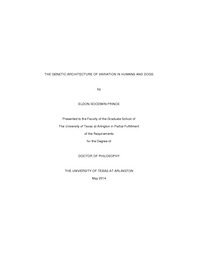
ATTENTION: The works hosted here are being migrated to a new repository that will consolidate resources, improve discoverability, and better show UTA's research impact on the global community. We will update authors as the migration progresses. Please see MavMatrix for more information.
Show simple item record
| dc.contributor.author | Prince, Eldon Goodwin | |
| dc.date.accessioned | 2017-05-31T19:22:32Z | |
| dc.date.available | 2017-05-31T19:22:32Z | |
| dc.date.submitted | January 2014 | |
| dc.identifier.other | DISS-12602 | |
| dc.identifier.uri | http://hdl.handle.net/10106/26671 | |
| dc.description.abstract | Genetic architecture is broadly defined as the structure of how genes come together to produce phenotypes. Primary aspects of genetic architecture include how many and which genes contribute to phenotypic variation. The genetic architecture of human height has been studied for over a century; indeed it is the classic quantitative trait with hundreds of contributing variants. As genome-wide studies of genetic architecture are extended beyond just humans, the genetic basis of polygenic traits like height can be compared between species. Such interspecies comparisons reveal how many of the same loci contribute to variation within each species. The extent to which the same loci contribute to intraspecific variation depends on species relatedness and reflects underlying constraints on genetic variability and variation. In this study genome-wide associations are compared between humans and dogs to estimate how many of the same loci contribute to intraspecific height variation. Due to the highly polygenic nature of height variation, one might predict that relatively few loci will be shared between species as distantly related as the human and dog. Contrary to this prediction, I find that at least 25 orthologous regions contribute to intraspecific height variation in humans and dogs, indicating perhaps less obvious constraints on genetic variability and variation. Height is decomposed in dogs using genome-wide associations to identify loci that are associated with limb, torso, and neck variation. To extend this approach, several height QTLs are correlated with bone measurements in an independent panel of mixedbreed dogs. The prevailing interpretation that morphological traits are genetically simple in dogs relative to humans is then tested. Central to the interpretation of genetic simplicity in dogs is the story of IGF1, a gene thought to explain the majority of size variation. The QTL effect size of IGF1 is tested in the aforementioned panel of mixed-breed dogs and I find that it explains much less variation than previously reported. This experiment and others call into question the Mendelian effect size previously attributed to IGF1 and the associated interpretation of genetic simplicity for dog morphology. One of the evolutionary forces that can impact the genetic architecture of traits is meiotic recombination. Preceding the exchange of genetic material between homologous chromosome pairs, double-strand breaks occur via proteins like Spo11 in yeast. Since all crossovers are the result of double-strand breaks, and these breaks are non-randomly distributed throughout the genome, many researchers have sought to understand the process that regulates where double-strand breaks occur. In addition, although not all double-strand breaks result in genetic crossover, the DNA repair process to rejoin them can be both biased and mutagenic. The protein PRDM9 is associated with almost all meiotic double-strand breaks in mice and is thought to play a similarly central role in humans, although the protein is absent in canids. Curiously, the loss of PRDM9 in the canid lineage also coincides with a genome-wide destabilization of repetitive GC content. I conclude this work with a study of the consequences of losing the meiotic recombination-associated protein PRDM9 and the mutagenic role this loss has likely had in shaping the canid lineage. | |
| dc.description.sponsorship | Fondon III, John W. | |
| dc.language.iso | en | |
| dc.publisher | Biology | |
| dc.title | The Genetic Architecture Of Variation In Humans And Dogs | |
| dc.type | Ph.D. | |
| dc.contributor.committeeChair | Fondon III, John W. | |
| dc.degree.department | Biology | |
| dc.degree.discipline | Biology | |
| dc.degree.grantor | University of Texas at Arlington | |
| dc.degree.level | doctoral | |
| dc.degree.name | Ph.D. | |
Files in this item
- Name:
- Prince_uta_2502D_12602.pdf
- Size:
- 3.852Mb
- Format:
- PDF
This item appears in the following Collection(s)
Show simple item record


